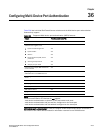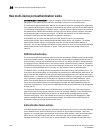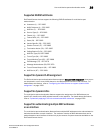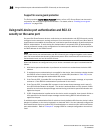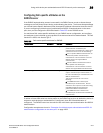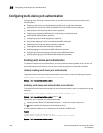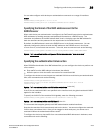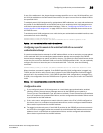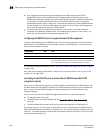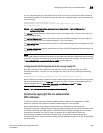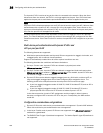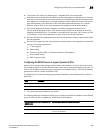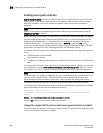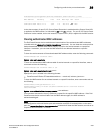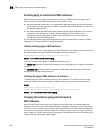
PowerConnect B-Series FCX Configuration Guide 1281
53-1002266-01
Configuring multi-device port authentication
36
If one of the attributes in the Access-Accept message specifies one or more VLAN identifiers, and
the VLAN is available on the Dell PowerConnect device, the port is moved from its default VLAN to
the specified VLAN.
To enable dynamic VLAN assignment for authenticated MAC addresses, you must add attributes to
the profile for the MAC address on the RADIUS server, then enable dynamic VLAN assignment on
multi-device port authentication-enabled interfaces. Refer to “Configuring the RADIUS server to
support dynamic VLAN assignment” on page 1282 for a list of the attributes that must be set on
the RADIUS server.
To enable dynamic VLAN assignment on a multi-device port authentication-enabled interface, enter
commands such as the following.
PowerConnect(config)#interface e 3/1
PowerConnect(config-if-e1000-3/1)#mac-authentication enable-dynamic-vlan
Syntax: [no] mac-authentication enable-dynamic-vlan
Configuring a port to remain in the restricted VLAN after a successful
authentication attempt
If a previous authentication attempt for a MAC address failed, and as a result the port was placed
in the restricted VLAN, but a subsequent authentication attempt was successful, the RADIUS
Access-Accept message may specify a VLAN for the port. By default, the Dell PowerConnect device
moves the port out of the restricted VLAN and into the RADIUS-specified VLAN. You can optionally
configure the device to leave the port in the restricted VLAN. To do this, enter the following
command.
PowerConnect(config-if-e1000-3/1)#mac-authentication no-override-restrict-vlan
When the above command is applied, if the RADIUS-specified VLAN configuration is tagged (e.g.,
T:1024) and the VLAN is valid, then the port is placed in the RADIUS-specified VLAN as a tagged
port and left in the restricted VLAN. If the RADIUS-specified VLAN configuration is untagged (e.g.,
U:1024), the configuration from the RADIUS server is ignored, and the port is left in the restricted
VLAN.
Syntax: [no] mac-authentication no-override-restrict-vlan
Configuration notes
• If you configure dynamic VLAN assignment on a multi-device port authentication enabled
interface, and the Access-Accept message returned by the RADIUS server contains a
Tunnel-Type and Tunnel-Medium-Type, but does not contain a Tunnel-Private-Group-ID attribute,
then it is considered an authentication failure, and the configured authentication failure action
is performed for the MAC address.
• If the <vlan-name> string does not match either the name or the ID of a VLAN configured on
the device, then it is considered an authentication failure, and the configured authentication
failure action is performed for the MAC address.
• For tagged or dual-mode ports, if the VLAN ID provided by the RADIUS server does not match
the VLAN ID in the tagged packet that contains the authenticated MAC address as its source
address, then it is considered an authentication failure, and the configured authentication
failure action is performed for the MAC address.



